Majestic and ancient, sea turtles on Ocean Isle Beach are one of our most beloved treasures. Each year, we roll out the red carpet for these incredible creatures. During the summer months, you’ll most likely see marked sea turtle nests on the beach since nesting season is at its peak from mid-May to mid-August. This blog has all the information you need about our sea turtle friends and what to expect during your NC beach vacation.
Visitors and locals are all encouraged to learn more about these flippered friends and do their part to remove our turtles from the endangered and threatened species lists. It is time to ask some serious questions and discover some fun facts about North Carolina’s sea turtles.
Sea Turtle on Ocean Isle Beach
Out of the seven species of sea turtles roaming the world’s oceans, five of them find their way to the shores of North Carolina regularly.
Types of Sea Turtles You May Encounter
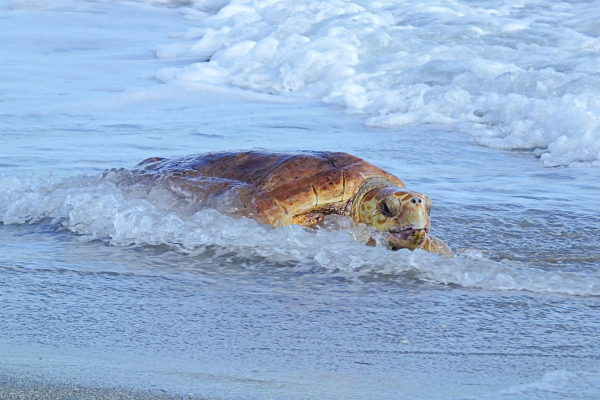
Loggerhead
If you see a turtle on the beach, it is most likely a Loggerhead. This species has an egg-shaped shell. Their skin is a tan/blonde hue. It has a proportionally large head.
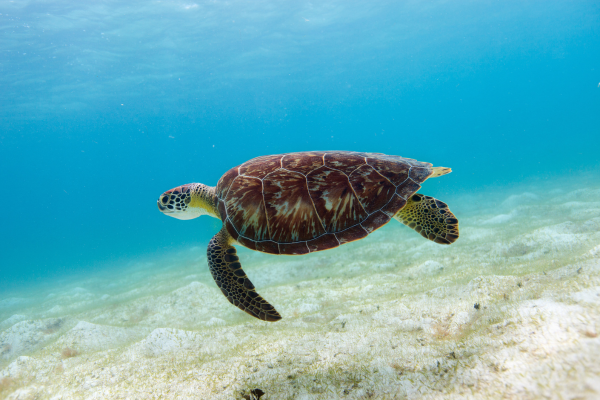
Hawksbill
Very rarely seen on Ocean Isle Beach, this turtle’s shell is yellowish brown with a marbled tortoise-shell pattern. Their scales overlap and appear ragged. The Hawksbill sea turtle’s head is slender with a bird-like beak.
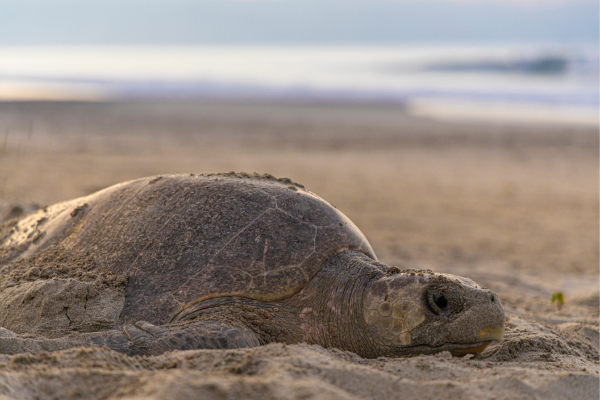
Kemp’s Ridley
Kemp’s Ridley sea turtles are the smallest in the world. This fairly common species has a round-shaped shell (length and width are similar). Their color tends to be a dull grayish/green/brown shell.
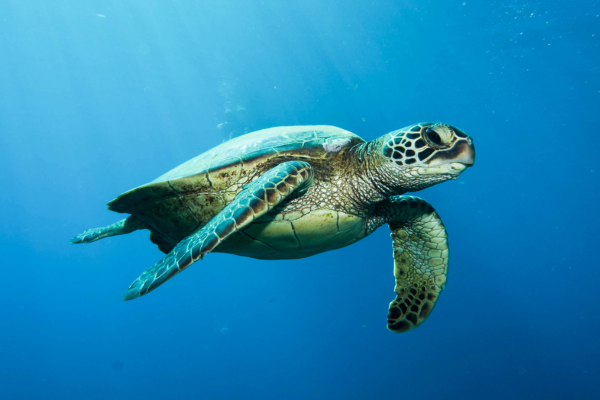
Green
Commonly found in our area, especially as juveniles. Their shells vary in browns and appear marbled with sunburst rays in each scute. Scutes do not overlap. They have a creamy underside, flat face, and serrated lower jaw.
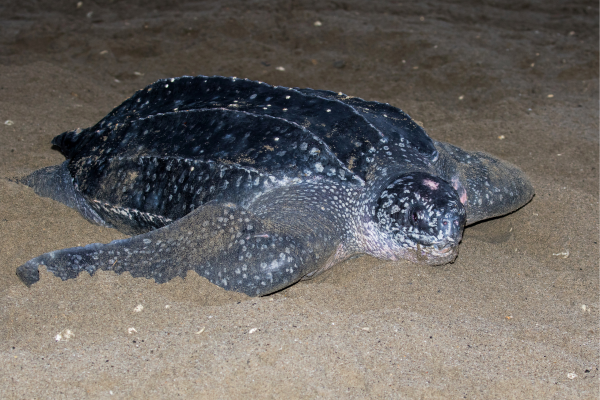
Leatherback
Uncommon in our area and rarely seen near shore, leatherbacks are the largest sea turtles on earth. They prefer wide sandy beaches close to deep water, so most leatherback nests in NC have occurred near Cape Hatteras, Cape Lookout, or Cape Fear. Leatherbacks are an endangered species.
What Makes Sea Turtles So Special
Sea turtles are fascinating in so many ways. In addition to being an exquisite member of the reptile family, they are also relatively rare. There are only seven species of sea turtles in the world, 6 of which are listed as threatened or endangered. Despite sharing a similar habitat, the five species that find their way to the North Carolina coast each year are all very different.
Feasting on a diet of jellyfish, seaweed, crabs, shrimp, sponges, snails, algae, and mollusks, sea turtles vary significantly in size and weight. The Kemp’s Ridley will grow to about 30 inches and 80-100 pounds, whereas the Leatherback can grow to lengths of 6.5 feet and weigh as much as 2,000 pounds.Once a sea turtle reaches reproductive age, they typically mate along the coastline, adjacent to nesting grounds. A female sea turtles will migrate back to the region where she was hatched, crawl out of the surf at night, dig a hole in the sand, deposit her eggs in the nest, cover it with sand, and then return to the ocean.
Sea Turtle Nesting and Hatching
Sea turtles are migratory. Female sea turtles return to where they hatched to lay their eggs each year. Amazing, right?! Sea turtles use magnetic fields, the slope of the shore, and moonlight to find their way to the perfect nesting spot.
Female sea turtles use their flippers to dig a hole, lay eggs, and cover them with sand. This is called a clutch. Each turtle can lay up to 120 eggs, each about the size of a ping-pong ball. The turtle then returns to the ocean and, after 12-13 days, returns to a beach to lay another clutch of eggs. Female sea turtles will lay between two and seven nests per nesting season. After this, she will return to the sea and take two or three years before she lays again.
Her eggs will hatch after about 60 days. The temperature of the sand determines the sex of the baby sea turtles. Warm sand results in female sea turtles, and cold sand results in male turtles.
Once ready to hatch, barriers are often constructed by the Ocean Isle Beach Sea Turtle Protection Organization (OIBSTPO) volunteers to decrease the chance of hatchlings getting stepped on, run over, or confused by lights. They take several days to hatch and crawl to the surface of the sand. When ready, they break the surface and scramble to the sea. This usually occurs at night and is referred to as a boil.
The hatching and boiling are beautiful sights to behold. Check out this amazing video. You can see why they call a sea turtle nest hatching a boil.
Like their mother, hatchlings use a combination of light, magnetic fields, wave action, and the slope of the beach to find their way to the surf. Once in the ocean, the hatchlings will swim for 24-36 hours to reach the Gulf Stream and the nutrient-rich seaweed beds, where they’ll spend the next ten years.
About three days after the hatching, volunteers with the sea turtle watch conduct an excavation and inventory of the nest. The nest will be filled with empty eggshells, unhatched eggs, and even hatchlings that didn’t survive. Each must be counted and recorded.
How to Protect Sea Turtles
The OIBSTPO’s mission is to provide a safe and protected environment for all sea turtles that frequent Ocean Isle Beach. In addition to identifying and marking nests on Ocean Isle Beach, they protect hatchlings from predators and transport sick and injured sea turtles to the Karen Beasley Sea Turtle Rescue & Rehabilitation Center on Topsail Island.
What You Can Do?
Protecting sea turtles on Ocean Isle Beach takes all of our efforts. Each of us can do things to help ensure our sea turtles have a safe habitat to continue their cycle of life. We encourage all visitors to look at the list below of things to do and not to do while visiting Ocean Isle Beach. With your help, we can ensure the long-term survivability of these beautiful creatures.
- If you see a sea turtle nest. Call the Ocean Isle Beach Police at (910) 579-4221 or the Ocean Isle Beach Sea Turtle Protection Organization Hotline at (910) 880-8715.
- Keep a safe distance. Keep away from turtles on the beach, especially moving turtles that may be looking for a nesting site. To observe, sit quietly away from the turtle.
- Leave turtle hatchlings on the beach. Call the hotline for directions: (910) 880-8715.
- Do not use artificial light sources. Turn off flashlights, cell phone screens, and all other ocean-side lighting during hatching or nesting events.
- Respect all nest markers. Report disturbances to the hotline: (910) 880-8715.
- Throw trash away and pick up litter on the sand and in the water. Remove beach litter, such as balloons and plastic bags, as they may be mistaken for food in the ocean and ingested by sea turtles.
- Level the sand. Fill in all holes on the beach at the end of the day, as they may become traps for female turtles that generally nest on the beach at night.
- Remove all beach furniture at the end of the day. Don’t leave any additional obstacles on the sand for nesting or hatching sea turtles.
- Keep pets on a leash and away from sea turtles and nests. Dogs are naturally curious and may cause unintended harm to nesting females, sea turtle eggs, nests, and hatchlings. Dogs on a leash are prohibited on the beach between 9:00 am and 6:00 pm from Memorial Day to Labor Day.
Thank you in advance for respecting our local wildlife during your beach vacation.
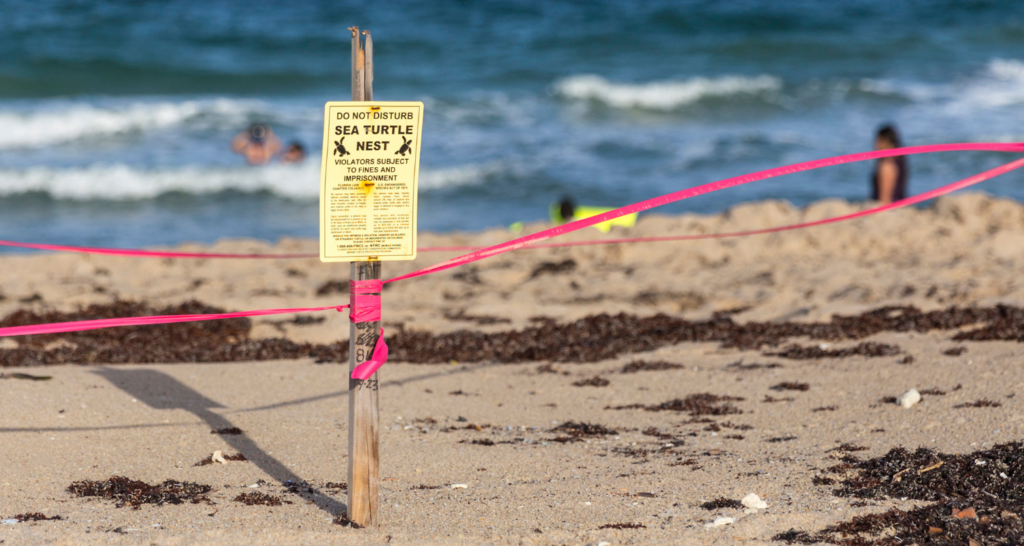
What Happened to the Sea Turtles?
There are several reasons why sea turtle populations have declined. They have been poached and exploited for their eggs, meat, skin, and shells. Habitat destruction along our coastlines and accidental capture in fishing gear has also been detrimental to sea turtles. Turtles have also been impacted by climate change, jeopardizing nesting conditions.
Beach day snacks and fun toys can create trash, leading to a turtle tragedy. In 2012, a Loggerhead sea turtle was found, nearly lifeless, floating in the inlet at Ocracoke Island, NC. She was transferred to The Karen Beasley Sea Turtle Rescue and Rehabilitation Center on Topsail Island, NC, where she was treated…and sadly died. During her time at the center, she passed various transparent plastics, styrofoam, string, and even a quarter. When turtles eat plastics, it causes them to feel full without offering any nourishment. Our trash spelled disaster for this Loggerhead. However, another turtle treated at the center had a much happier ending. A green turtle had been found near Shackleford Banks, and after several weeks, she passed two small balloon pieces. This could have been life-threatening, but the turtle was released back into the ocean after proper treatment and rest.
Turning the Tables for Sea Turtles
It has been reported that only 1 in 1,000 hatchlings will live to reproduce. To turn around the sea turtle crisis, locals and visitors should endeavor to make small efforts that could significantly increase the survival rate of our sea turtle friends. Allowing greater opportunity for juvenile turtles to grow to maturity and then have sustainable nesting grounds is a big part of sea turtle conservation. Located in the southern reaches of the NC coast, Ocean Isle Beach usually receives around 25 nests each summer.This is an opportunity for thousands of Leatherback, Loggerhead, and Green sea turtle hatchlings to thrive.
To learn more about sea turtles on Ocean Isle Beach, attend the Sea Turtle Talks over the summer months. They are very informative, and we highly recommend them.

Get a front-row seat to all the best beach activities when you book an oceanfront vacation rental. We can’t wait to see you at the beach!


